Cybersecurity Content Writing: How to Hack Your Readers into Buying Your Security Services

If you are a cybersecurity expert, then you’ve definitely been busy in the past few years. The industry has had a stunning growth rate fueled by the equally stunning growth of cyberattacks. Along with the industry, the importance of marketing for cybersecurity companies has also increased. Cybersecurity content writing has also evolved: from press-like articles about fending attacks to in-depth pieces targeted to experienced individual and enterprise users.
But more on that later.
For now, let’s take a quick look at the numbers.
The Cybersecurity Industry — a Behemoth in the Making
The global cybersecurity industry has been on the rise for the past six years. When the pandemic hit, the market became the prime focus of newscasts and…pretty much everyone.
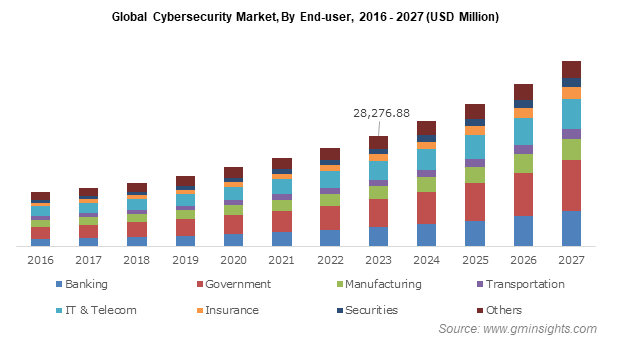
Image via Global Market Insights
Why? Because the pandemic also brought about a huge increase in cyberattacks, especially ransomware. Both residential and enterprise users were targeted. Of course, the biggest ransoms came from enterprise users.
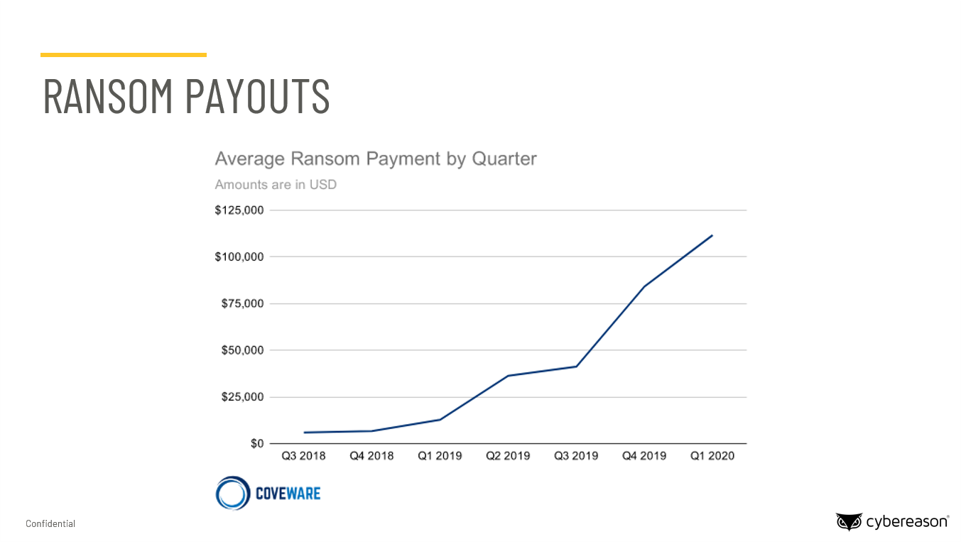
Image via ThreatPost
If you take a close look at the two graphs, you’ll see that the upward trend of ransomware payouts and the growth of the cybersecurity market follow a similar trajectory. That’s basic supply and demand for you.
A growing market is usually good news for everyone in it, right? Right!
But there’s always a catch: a growing market also means more competition. As the number of cyberattacks increases, so does the number of companies that offer their services to protect users from said attacks or at least to help them recover their data in case of successful ransomware attacks.
So how do you stand out from the crowd? What can you do to get your cybersecurity services or solutions in front of the right eyes?
From all the marketing tactics we have used from our customers in this industry, the most effective (by far!) was cybersecurity content. Scroll down to learn why.
Need content writing for your cybersecurity company? We can help! Copywritech partners engineers and marketing writers to get unique pieces that can explore technical subjects in a way that’s accessible for everyone — tech experts and laymen. Let’s talk about your content strategy!
Why Invest in Cybersecurity Content Writing?
Why opt for content writing to promote your cybersecurity solutions when you could go the regular route: paid ads and sponsored posts? To be fair, both of these options are easier. But cybersecurity content writing helps with a few things paid ads can’t.
1. Content Writing Educates
People are worried about a lot of things cybersecurity can mitigate: having their data stolen, having their identity stolen, or simply being a victim of any type of attack:
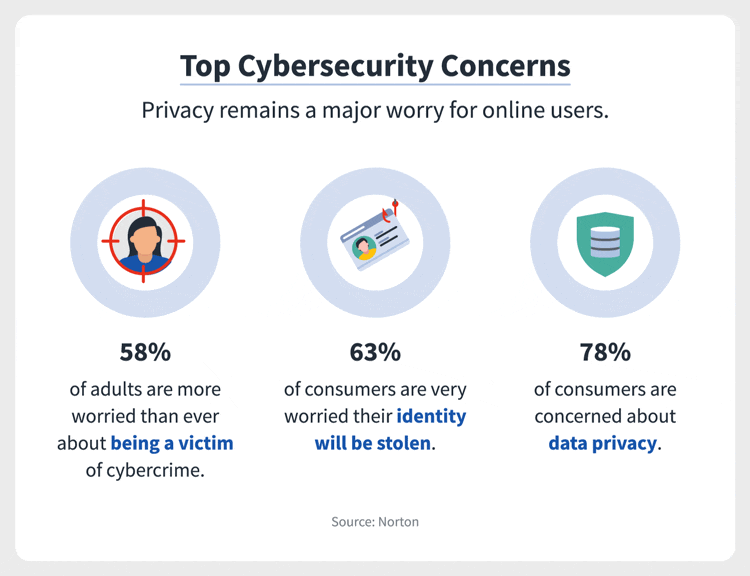
Image via Norton
Still, very few people know how to protect themselves from attacks. A staggering 68% of users have never had cybersecurity training:
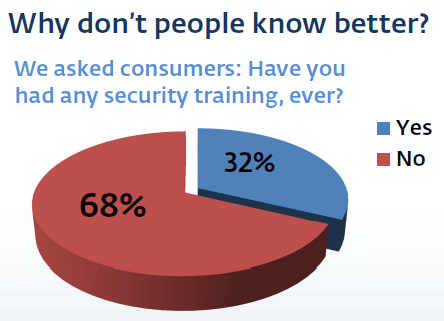
Image via We Live Security
Only 5% of companies’ folders are protected the right way. Worse yet, 77% of companies don’t have a security incident plan.
For most people (executives included!) phishing, ransomware, and malware are words that make very little sense. There is a clear need for education around cybersecurity.
Before you pay for and add advertising your vulnerability scanning or your pen testing solution, ask yourself this: does your target audience know what these words mean? If not, it’s time they knew.
Cybersecurity content writing educates your audience. It creates knowledgeable potential clients who understand that they are at great risk without a proper security solution.
In-depth, authority content writing on cybersecurity topics is the cornerstone of a valuable sales funnel. By explaining the risks, you emphasize the need for your solutions. The next stage of the funnel: explaining why you are the best solution for your readers’ cybersecurity needs.
2. Cybersecurity Content Writing Establishes You as an Authority in the Field
You’ve started by educating your readers. They now know that they need a cybersecurity solution to help them prevent attacks that might cost millions of dollars.
But where are they going to get such a solution from?
The company that sheds light on their needs, of course.
If you managed to get their attention, you have a great chance of also getting their business.
It’s cybersecurity: if they learned something from your content is to never buy something from an untrusted source. You, the company that (obviously!) knows about cybersecurity, are automatically added to the do-trust list.
From here on, there is one step left:
3. Content Writing Sells!
84% of consumers bought something after reading about it on a blog. More importantly, 56% of marketers say that blogging actually leads to purchases.
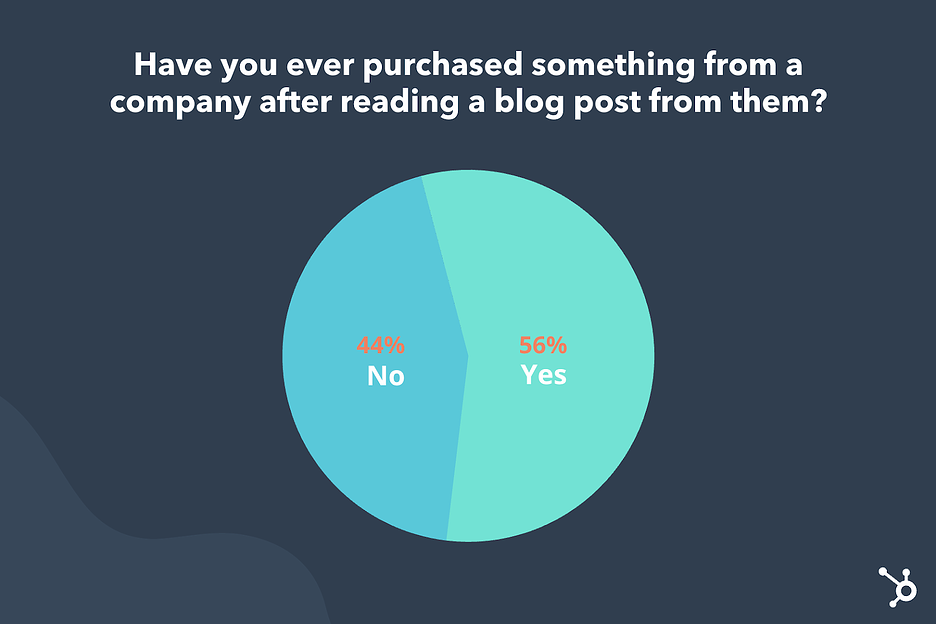
Image via HubSpot
And that’s just blogging! There are countless other types of content you can use in your content strategy.
In our work with clients in cybersecurity, we found that a sales funnel made of blogs, whitepapers, and user-oriented website copy was an excellent way to get leads that are ready to convert. Establishing authority in a world full of scammers is, perhaps, the hardest stage of the content marketing funnel.
Once you’ve got that covered, getting leads and converting them is (almost) easy.
4. It’s the Ethical Thing to Do
Cybersecurity is on everyone’s mind. Even the White House takes it seriously, pledging to bolster the nation’s defenses. A lot of companies are already investing in educating the public about cybersecurity risks and protection measures.
Free ransomware security tools are already the norm. It’s become a moral duty of cybersecurity companies to take the time and the budget to help get rid of cybercrime groups.
And education is the primary way to fight cybercrime. Informed people are rarely victims. They know, for instance, that they shouldn’t pay ransoms but go to the authorities instead.
To recap: cybersecurity content marketing can help you sell more, establish yourself as an authority in the field, and pay a moral debt.
That’s all great. But how do you create cybersecurity content that educates and sells?
Let’s find out!
4 Steps to Cybersecurity Content that Educates, Converts, and Sells
Writing on cybersecurity topics is challenging. If you’re an expert in the field, you have to tone down your use of jargon. If you’re not, you have to become one. Neither of these things is easy.
But they can be done! (We have proof of it!)
Check out our agency’s process to create engaging and high-ROI cybersecurity content.
Step 1: Know Your Target Audience
The first thing we do when we onboard a new customer in the cybersecurity industry is to dive deep into their buyer persona. Is their security solution created for:
- Individual users,
- Parents,
- Enterprises?
That’s just scratching the surface — things you can find out with a single glance at their website. In order to create compelling content, we also ask other questions. For instance: if your solution is for enterprise use, it is a better fit for small businesses or large companies. Is it scalable? Can it grow along with the company?
Moreover, is your solution usable by people with no or little IT background? Does the client need their own IT department to implement it? Can it be monitored from a distance?
And so on.
These are just a few of the questions that help us zero in on the ideal buyer for our customer.
The bottom line: if you’re selling a security solution that’s for everyone, it’s for no one.
I know, a ransomware decryption tool, for instance, can be used by a multinational company the same way it can be used by Fred and Angela who share a laptop to FaceTime their kids. But the way you talk to a multinational company is different from the way you talk to Fred and Angela.
And when you write cybersecurity content, these things matter. You have to know if your reader understands technical terms (even if it’s just at beginner level) or if you have to “humanize” every word.
So, before getting started on your content, work harder on your buyer persona. How can you help them? This is the first question that you need to ask before writing anything.
Step 2: Explain the Risks but Avoid Fear-Mongering
The increase in cybercrime is no joke. Everyone is at risk. Whether your client has the risk of losing their family photos or a database of clients worth millions of dollars is another discussion.
However, your cybersecurity content needs to clearly explain these risks. While losing your family photos may seem like a small risk, most individual users beg to differ.
So it’s up to your cybersecurity content writer to make those risks clear and segment them according to your buyer persona. Your goal is to create a sense of urgency without resorting to fear-mongering.
You don’t want to sound like a snake-oil salesman who has the cure for that dreadful disease you’re definitely suffering from. But you want to make the risks clear.
It’s a fine balancing act, I know. This is why you need excellent content writers for cybersecurity topics.
Step 3: Position Yourself as the Solution
Now that your audience knows the risks, what can they do? Of course, they can do more than hope for the best.
They can use your solution to protect themselves from a cyberattack or to minimize its impact if the attack already happened.
Irrespective of the type of content you create, a CTA is a must-have. Don’t let people deduce that you sell cybersecurity solutions — tell them and make it clear!
For example, in an article about ransomware risks for SMEs, add a CTA that says: “Our solution has been used by 1,800 SMEs so far. Want to try it out too?” or “We create cybersecurity solutions for SMEs just like yours. Frequently updated, budget-friendly, and with 24/7 support. Click here to start protecting your business!’
As always, balance is key. Don’t make your content unbearable to read by adding three pop-ups and four huge CTAs. Keep your pitch to a minimum but add it in key places.
People skim. 55% of users will only read your content for 15 seconds or less. If you got this far, you’re part of a select minority.
But it’s not wise to bet that all your readers are part of the same minority. So make it easy for them to spot your CTA. Add it as early as possible in the content and make it easy to spot without being too blatant. For instance:
- Use bold fonts.
- Use italic fonts.
- Add a button in a different color.
- Space it out from the rest of the text. Don’t be afraid of white space — it’s your friend and the best way to improve the readability of any piece.
Step 4: Create a Sales Funnel Based on Your Cybersecurity Content
Go back to your buyer persona. Yes, again! It’s always the place to start when in doubt. How much do they know about cybersecurity? Are they security experts, IT managers, C-level executives with no tech background, or individual users with no tech inclinations whatsoever?
The answer to the question above will dictate more than the tone of your cybersecurity content. It will also tell you where to start your funnel.
Let’s look at an example.
Say your buyer persona is someone who has a minimal understanding of cybersecurity. They know the big picture (ransomware is everywhere, phishing is also rising, and so on). Most likely, they will not click on a link in an email from a currently distressed prince promising them millions of dollars in exchange for their credit card number.
But they don’t know exactly where to start getting protection from every cyber threat out there. In this case, your job (read: the job of your cybersecurity content) is to add more details to the big picture they already know and to explain what risks are more immediate for them, given their particular situation.
Here’s a quick outline (with resources to support your claims):
- Things are bad.
- Everyone can be a victim of cybercrime (yourself included — here’s why you/your company can be a victim).
- But there are solutions. Not all is grim.
- Check out how our solution can help you mitigate all the risks described above.
- Social proof (customers that you have already helped and that have shared their gratitude in a testimonial).
The outline above can be a blog post, a whitepaper, an eBook, an email, and so on.
Better yet, it can be your sales funnel:
- A blog post that outlines the risks (educate your audience).
- Another blog post that targets the buyer persona even more precisely, with risks segmented according to their needs.
- A whitepaper that outlines your proprietary solution (that people can download in exchange for their email address).
- Social proof sent via email to the people who downloaded your whitepaper.
This is just an example. In real life, you can play with the items above any way you see fit. For instance, social proof can be added at the end of every type of content. You can position yourself as the solution in a CTA in every blog post you write (you don’t have to wait for the whitepaper to be ready). You can use parts of your blog posts to create a downloadable eBook. And so on.
Once you have the top-quality cybersecurity content figured out and your buyer persona known in detail, you’re free to re-use, repurpose, and re-target your audience.
Final Thoughts
Cybercrime isn’t going anywhere any time soon. That’s good for your business — but also for those of your competitors.
Cybersecurity content writing is a valuable tool in your marketing arsenal. It can help position you as a thought leader in your industry and it can spark sustainable growth.
Need help creating cybersecurity content that ranks and converts? Talk to us! We’ve helped cybersecurity companies just like yours increase their market share through content written by a team of engineers (who understand cybersecurity) and marketing writers (who know how to translate technical terms into actionable items).